Tired, Yes
But not sick of talking about cool things I think you’d be interested in from the recent California Spring Trials. Not in the least! I have a few additions to the hundreds of items we called out during our six-part Acres of Buzz.
You all know I love growing veggies, so it won’t surprise you I’m super-excited about a new miniature butternut squash called Butterbaby from PanAmerican Seed. Small-sized versions of larger, space-hogging vegetables are not only what today’s home gardeners want—they are what these folks need.
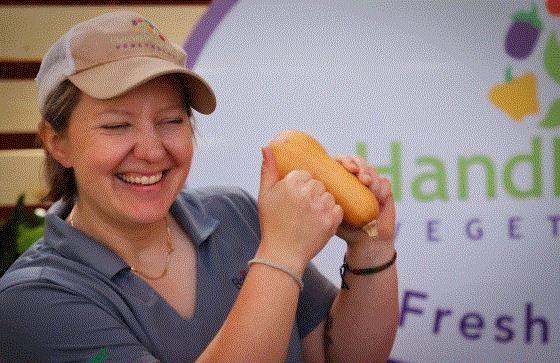
Susannah Ball loves this little Butterbaby squash from PanAmerican Seed!
At just a 7-10 ft. spread, Butterbaby takes up way less space than a traditional squash plant. Leaves are smaller, too. And the entire plant has resistance to powdery mildew.
As for the squash, each plant produces about 10 1-lb. fruits (consider it a single-meal size) that have a storability of several months. The one in the photo has been stored since last autumn! I’ll gladly pass this plant along to my fellow community garden gardeners—that way maybe their vines won’t creep into my plot.

It’s For the Bees
And for any sort of pollinators, really. This Insect Hotel constructed by gerbera breeder Florist at the GroLink stop shows folks how they can create a home for different pollinating insects—and all without the risk of actually drawing those critters to a place bustling with people, like a busy garden center.
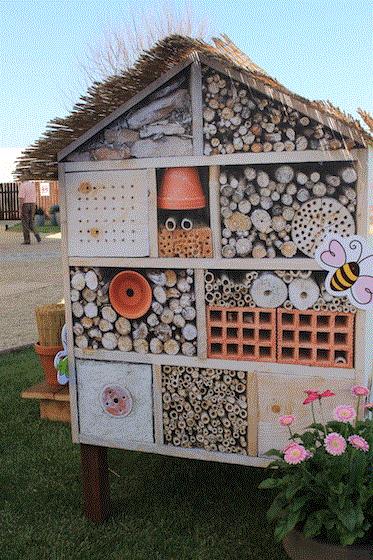
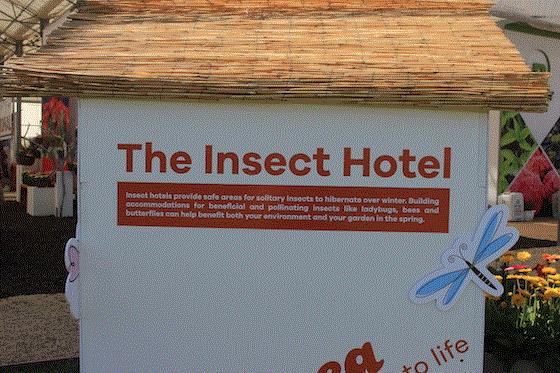
This Insect Hotel’s “rooms” are photos on two of the side panels, with the other panels having a description of what this structure can be used for. For a garden center, panels can show what a protective pollinator house could look like, describe what it’s for and then list the items they’d need to make this structure. I’d be totally into making this and I bet other gardeners would be, too.
A Triple Encounter
The side of me that has a soft spot for relatively insignificant perennials has always liked gaura. Don’t take offense, gaura! It’s just that one doesn’t see it all that often. And when I do see gaura, I kind of get excited and appreciate whoever planted it in her yard. Kinda like when I see another left-hander.
This past Trials I felt like gaura had a coming out party. We saw it at least three times, and each time, she had a different type of dress on. I believe we already mentioned Walberton’s Silver Fountain from PlantHaven—with white and green variegated leaves, and sterile, white (and sometimes pinky white) flowers.
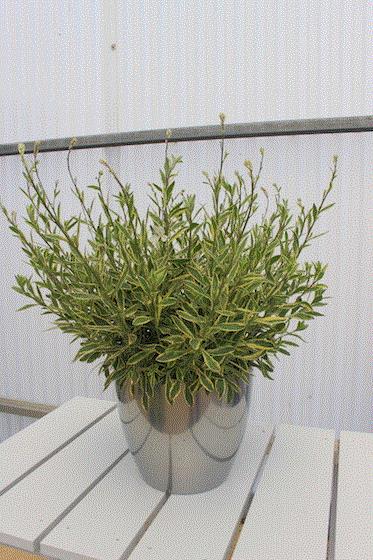
And we also mentioned the new addition to Hishtil’s Summer Star series called Star Baby—a true dwarf, growing no more than a foot tall or so, with flowers that just hover above the plant. Chris called it impressive due to its “retailability;” that is, you can squeeze a lot on a bench and they are beautifully showy plants.
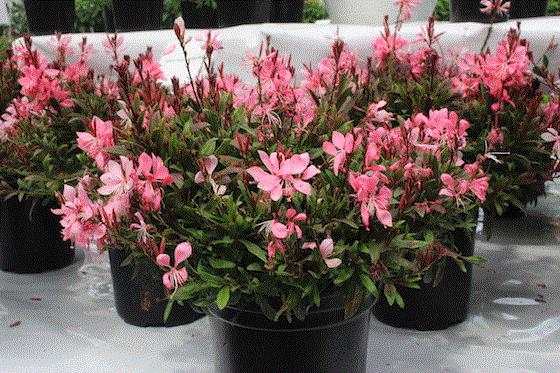
There was a third we saw, this one from Dümmen Orange, and I must have been impressed with it because it was the last Dümmen plant I photographed before nearly keeling over with faintness (I had a strange 24-hour dizzy spell for some reason). Like PlantHaven’s, this one had variegated leaves but with a green/pink/maroon-variegated pattern. Unfortunately, I took no notes about it, so all I know is that it’s experimental! But what struck me about this was the colorful foliage. Shows you that gardeners don’t need to rely on flowers for that dose of vibrant color their gardens need.
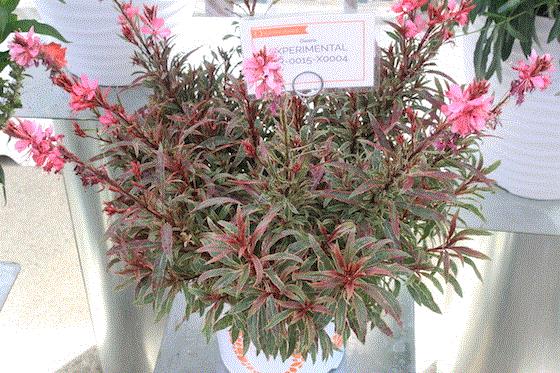

Riser to the Top
We don’t tend to cover hard goods companies that display at Spring Trials, mainly because Trials is all about the plants. But I do want to mention a product from MasterTag that I thought you should know about.
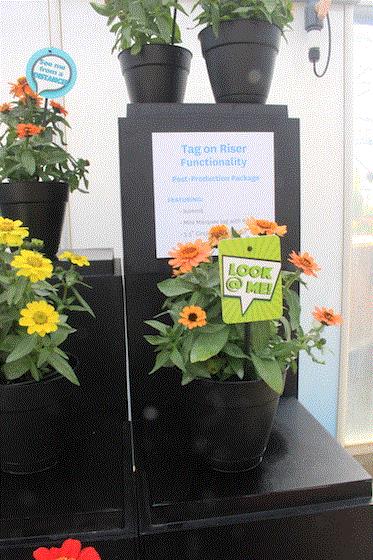
It’s the tag on a riser. MasterTag’s Joe Fox said tags on risers are a very European way of doing things. Rather than bending down to read product names and information tucked among the foliage, all of the need-to-know stuff is held above, and that much closer to the person needing to see it. Tags on risers also draw that much more attention to the item you're trying to sell. Like that tag in the photo, it’s screaming, “Look at me!”
Hey, it’s Arbor Day!
This Friday is Arbor Day, and to honor the day, I’m going to pass along some info about one of my favorite non-flowering trees, Metasequoia glyptostroboides. This baby is the complete opposite of small-space gardening, but man oh man, I’d love to have one. I had no idea there were cultivars of this giant, but Matthew Chappell enlightened me and readers of his Nursery & Landscape Insider e-newsletter. Here’s what Matthew had to say:
All of those high maintenance “flowers” at Spring Trials are cute, but I’m more of a tough plant guy. That’s why I dig trees and shrubs and always will.
One of my favorites, particularly as foliage emerges in the spring, is Metasequoia glyptostroboides Ogon. Why do I love it so? It’s tough to remember all the reasons, but I’ll try. It maintains a central leader without any need to prune. Its chartreuse foliage color serves as a focal point season-long and can draw someone through a garden. It’s pretty much bulletproof as far as insects and diseases are concerned. It can tolerate all soil types, although it does better with readily available soil moisture. Its soft foliage makes me want to stop and pet it. (Don’t judge, people! Petting plants is acceptable, as long as they’re not too thorny.)
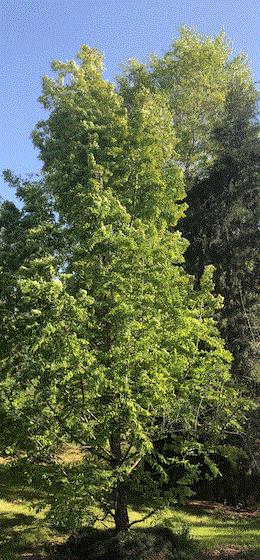
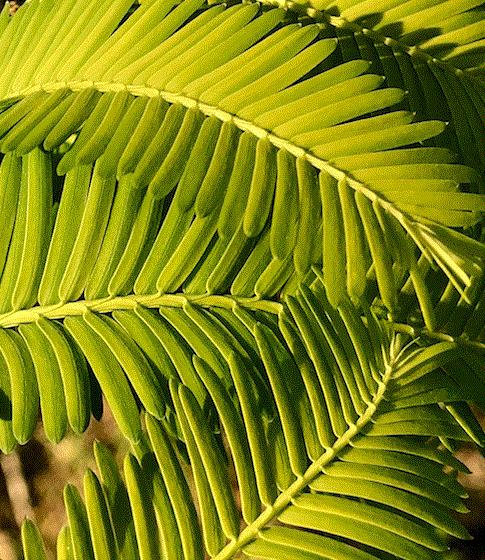
Hardy from Zone 5a to 10b, it’s difficult for me to understand why this tree isn’t planted more frequently. Yes, it's a big tree at maturity, reaching 75 to 100 ft. in height and 20 to 30 ft. in width. But gracious, folks, we plant Leyland cypress all the time and it’s just as large at maturity (even if it never gets there in the east due to seiridium canker). It also does best in areas with consistent soil moisture availability, although it can persist through temporary drought conditions.
I recommend this tree constantly, even though few people listen to me (sad face), and I suggest you grow and plant this tree more frequently.

#Garden4Wildlife
May is National Wildlife Federation’s Garden for Wildlife Month, and GrowIt! is once again partnering with NWF to help spread the word for a second year in a row.
Just like those insect hotels mentioned above, gardens are spaces that provide food, water and shelter for all sorts of wildlife. Last year, GrowIt!, the social gardening app, helped communicate the importance of gardens to wildlife through the #Garden4Wildlife hashtag. This year they hope to get even more gardeners involved by asking people to snap pics of what they are doing to promote wildlife habitat in their yards, and then post it to GrowIt! with the hashtag #Garden4Wildlife to show and share. (I’ve got a great photo of a bunny chewing my kale plants I can post! Does that count?)
All joking aside, we’re much more visitors in their environment then they are in ours. It’s important to learn how we can all coexist within an outdoor environment—whether it’s a woodland forest, a park or a backyard. This Garden for Wildlife Month is a time when we can all learn from each other how to do it best.
To learn more about what GrowIt! and NWF are doing, go HERE. Garden centers, what are you doing to teach your customers about gardening for wildlife?

Webinar Alert!
We’ve got another webinar on LED lighting for you. This one is called LED Lights for Sole-source Propagation, scheduled for Tuesday, May 1, at 1:00 p.m. Eastern/12 noon Central. Chris Beytes will once again play host to a couple of LED geeks from Philips, Dr. Abhay Thosar and Blake Lange.
If you’re a grower of young plants, URCs or seeds, this is a can’t-miss opportunity to learn some of the solutions to challenging growing situations like disease, temperature, humidity and irrigation uniformity. To give you the best control over growing at this critical young stage, you may find that a sole-source lighting approach works best for you. The lighting pros will explain:
-
Why and when to consider a sole-source lighting scenario
-
How to get started
-
Research results for a variety of crops, including ornamentals, greens and herbs.
Head on over to www.GrowerTalks.com/webinars to sign up for it. And if you can’t make it next Tuesday, that’s the same address you can go to later on to find an archived edition of the webinar.

Guess Who’s 80?
Whether you’re a person, a company or even a tree, 80 years is a long time to be around. Hiawatha Evergreens can count themselves among those who have reached that milestone. Starting out back in 1938 as a local supplier of fresh evergreens, Hiawatha is now an international distributor that employs more than 700 folks during harvest time to supply their florist, grocery, mass market retailer, garden center and crafting customers with a wide range of decorative greens, moss and pine cones. They’ve even gotten into e-commerce and have experienced a significant increase in drop ship orders.
Gosh, 80 years … doesn’t get any more evergreen than that! Congrats, Hiawatha!
If you have any comments on your season thus far, or have any additional questions, comments or suggestions, email them to me at ewells@ballpublishing.com.

Ellen Wells
Editor-at-Large
Green Profit
This week's BuZZ! was sent to 21,066 loyal readers!
If you're interested in advertising on BuZZ! contact Kim Brown ASAP!